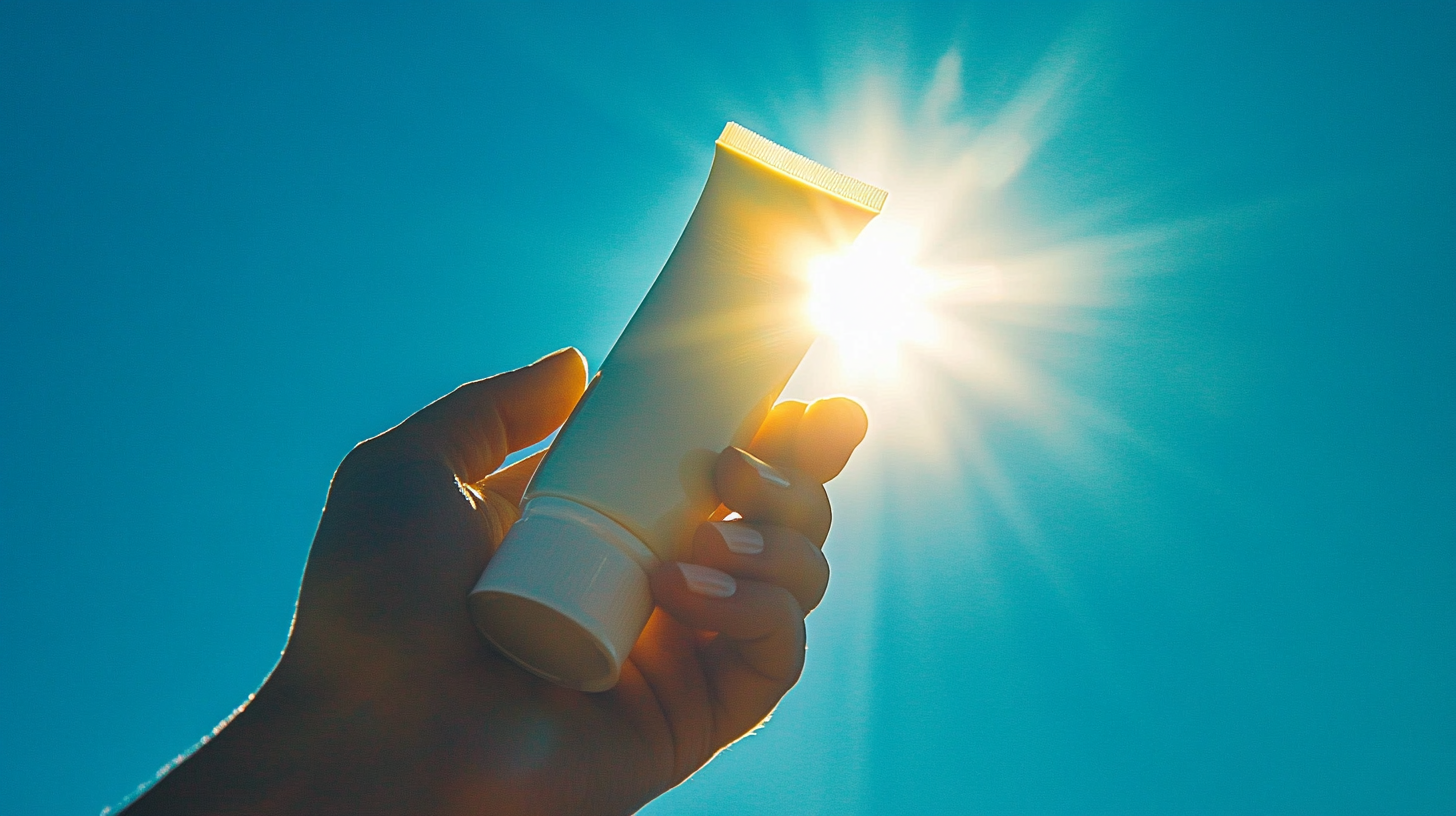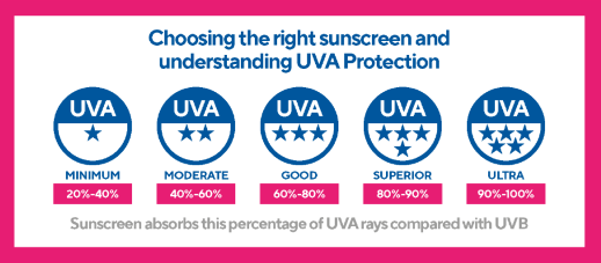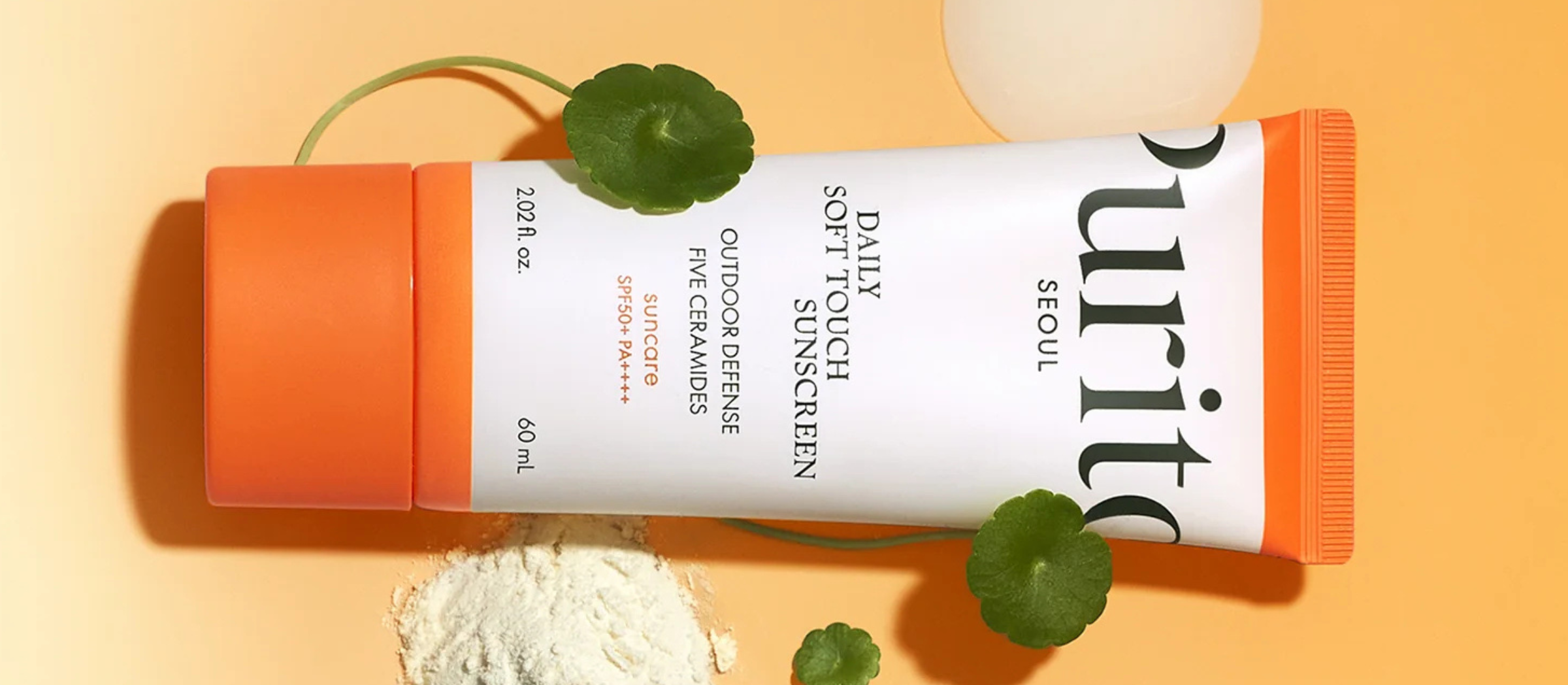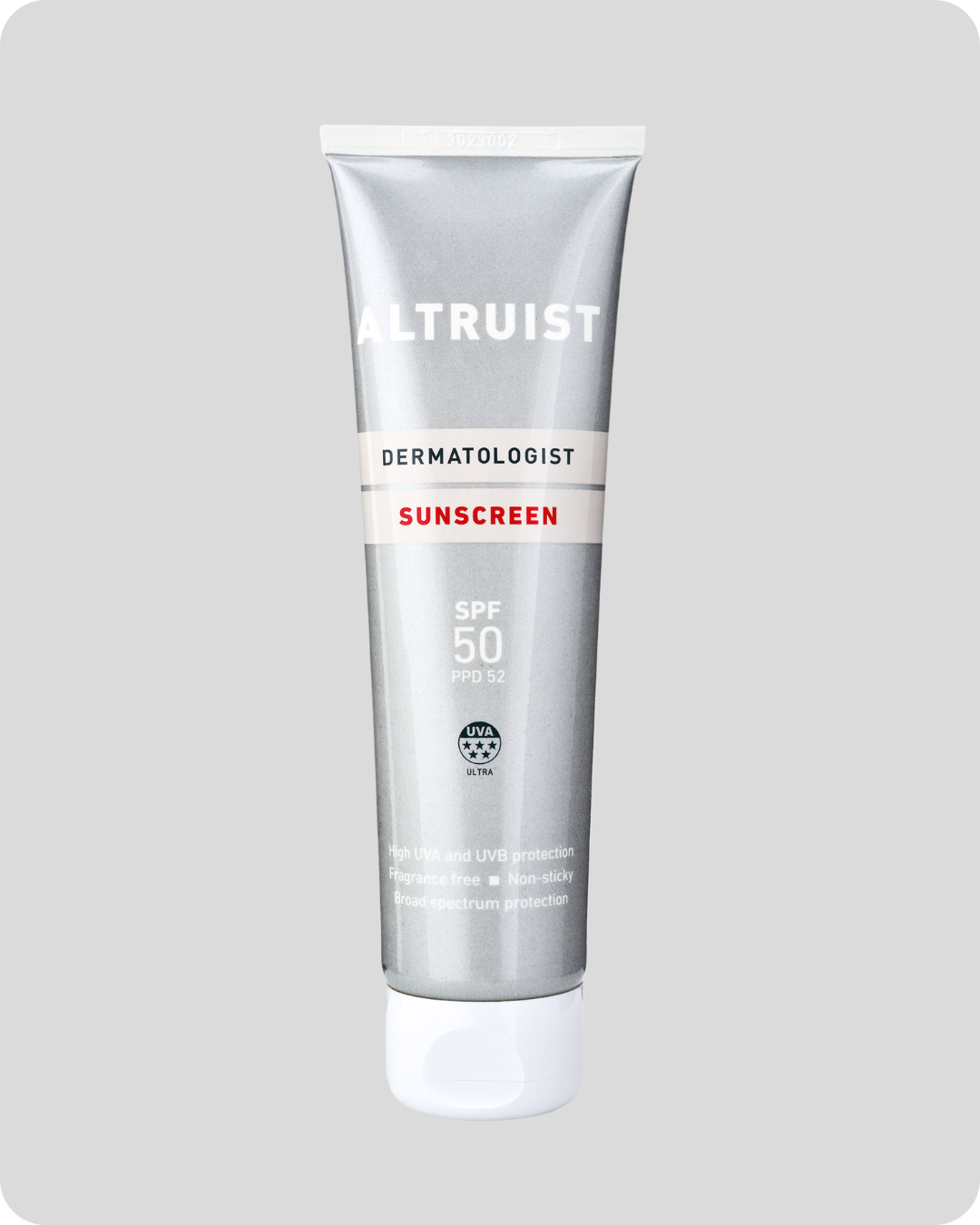

Understanding UVA & UVB: The Key to Smarter Sun Protection
Sabina JasinskiWant to understand why sunscreen is a must—even on cloudy days?
In this post, we explain the difference between UVA and UVB rays, how they affect your skin, and how to choose the right sun protection to guard against both aging and sunburn."
UVA & UVB: What’s the Difference and Why It Matters for Your Skin
Ultraviolet (UV) radiation from the sun reaches our skin in two main forms: UVA and UVB.
While both types of rays can damage the skin and contribute to skin cancer, they work in different ways—and understanding the difference is key to protecting your skin properly.
UVA vs. UVB: How They Penetrate the Skin
- UVA RAYS have a longer wavelength, allowing them to penetrate deeper into the skin, reaching the dermis (the middle layer). These rays are primarily responsible for premature skin aging—wrinkles, sagging, and pigmentation. UVA also contributes to skin cancer, mainly through indirect DNA damage caused by free radicals.
- UVB RAYS have a shorter wavelength and mostly affect the epidermis, the outer layer of the skin. These are the rays that cause sunburn and play a major role in direct DNA damage, which can lead to skin cancer.
UVA = AGING
- Causes up to 90% of visible facial aging
- Indirectly damages DNA through free radical formation
- Triggers melanin production (leading to tanning and pigmentation)
- Longer wavelength, lower energy, deeper penetration
- Exists as UVA1 (340–400 nm) and UVA2 (320–340 nm)
- Makes up over 95% of the UV radiation that reaches Earth
- Present year-round, from sunrise to sunset
- Can pass through glass (windows, car windshields)
Not measured by SPF – measured using:
- PPD (Persistent Pigment Darkening)
- UVA circle (1/3 of SPF, common in Europe)
- PA+++ rating (common in Asia)
- Critical wavelength for broad-spectrum products
-

UVA Circle
Check for the UVA CIRCLE on the packaging. We recommend looking for 4-5 star UVA protection
-

PA+++
- PA+ = Some UVA protection.
- PA++ = Moderate UVA protection.
- PA+++ = High UVA protection.
- PA++++ = Extremely High UVA protection.
We recommend looking for products laberld with PA+++ and PA++++
UVB = BURNING
- Responsible for sunburn
- Directly damages DNA
- Triggers melanin production
- Shorter wavelength, higher energy, limited to the epidermis
- Makes up less than 5% of total UV radiation
- Most intense during midday hours and summer
- Does not pass through glass
Measured by SPF (Sun Protection Factor)
SPF 4 blocks about 75% of UVB rays
SPF 15 blocks about 93% of UVB rays
SPF 30 blocks about 97% of UVB rays
SPF 50 blocks about 98% of UVB rays
No sunscreen blocks 100%, and the difference between SPF 30 and 50 is small—but every extra percent counts, especially if you’re sensitive or spending time in strong sun.
✨ Important: Higher SPF doesn't mean you can stay in the sun longer without reapplying. Reapply every 2 hours, no matter the number.
Broad-Spectrum Protection: Covering Both UVA and UVB
When a sunscreen is labeled as broad-spectrum, it means it protects against both UVA and UVB rays. A true broad-spectrum sunscreen contains filters that cover the entire UV spectrum, from UVB (290–320 nm) to UVA (320–400 nm).
Choosing a broad-spectrum sunscreen is essential to provide comprehensive protection against both sunburn (caused by UVB) and long-term skin damage, such as premature aging and increased risk of skin cancer (caused by UVA). By using a broad-spectrum sunscreen, you ensure your skin is protected from all the harmful effects of UV radiation.
Photostable Filters = Lasting Protection
Combining broad-spectrum coverage with photostable filters gives you long-lasting, reliable defense against all forms of UV damage.
Photostability plays a key role in effective sun protection. When UV filters aren’t photostable, they can break down quickly in sunlight—reducing your sunscreen’s ability to protect against both UVA and UVB rays. This is especially important for UVA protection, since UVA rays penetrate deeper into the skin and are present all day, all year. A photostable UVA filter ensures long-lasting defense against premature aging, hyperpigmentation, and long-term skin damage. For UVB, photostability helps maintain reliable protection against sunburn and supports overall skin health during sun exposure.
- Tinosorb S (Bemotrizinol)
- Tinosorb M (Bisoctrizole)
- Uvinul A Plus (Diethylamino Hydroxybenzoyl Hexyl Benzoate)
- Uvinul T 150 (Ethylhexyl Triazone)
- Mexoryl SX/XL (Ecamsule/Drometrizole Trisiloxane)
- Zinc Oxide and Titanium Dioxide
Avoid relying solely on older, less stable filters like Avobenzone, unless they are stabilized by other ingredients in the formula (which some well-formulated sunscreens do).
So, what’s the solution?
Look for this on the packages:
🔍 Broad Spectrum – This means protection from both UVA and UVB rays.
🔍 SPF 30 or higher – SPF protects from UVB, and 30+ gives a solid daily baseline.
🔍 UVA protection markers – These might appear as:
- UVA circle symbol (used in Europe) or
- PA+++ (Used in Asia)
.
🔍 Photostable filters – Some UV filters break down in sunlight. Photostable ones stay effective longer.
✨ Bottom line:
Sun protection isn’t just for sunny days or summer vacations — it’s one of the most powerful daily habits you can build for healthy, radiant skin in the long run. By understanding how UVA and UVB rays work, and choosing the right sunscreen, you're giving your skin the defense it deserves.
Whether you're commuting, working by a window, or out for a cloudy-day walk — your sunscreen is working quietly in the background to protect you.
✨ Choose one you love
✨ Apply every morning, rain or shine.
✨ Reapply every 2 hours, especially if you're sweating or swimming.
✨ Use enough: about a teaspoon for the face and a shot glass for the body.
Your future self (and skin!) will thank you.
🧴 Ready to find your perfect match?
Check out our sun care collection — packed with high-performance, broad-spectrum options that feel just as good as they protect.
Sunscreen SPF50 100ml
- Regular price
-
166 kr - Regular price
-
- Sale price
-
166 kr
Tax included.
Shipping calculated at checkout.


Glossary: Key Terms Explained
UVA (Ultraviolet A)
Long-wave UV rays that penetrate deep into the skin (dermis). Responsible for skin aging, wrinkles, and long-term damage. Can contribute to skin cancer.
UVB (Ultraviolet B)
Short-wave UV rays that affect the surface of the skin (epidermis). Main cause of sunburn and also contributes to skin cancer.
SPF (Sun Protection Factor)
A measure of how well a sunscreen protects against UVB rays. Higher SPF = more protection from sunburn.
Broad Spectrum
Indicates that a sunscreen protects against both UVA and UVB rays.
PPD (Persistent Pigment Darkening)
A method of measuring UVA protection, mainly used in Europe and Asia. Higher PPD = more UVA protection.
PA+++
A rating system for UVA protection used mostly in Asia. The more plus signs, the higher the UVA protection (e.g., PA+, PA++, PA+++, PA++++).
UVA Circle Symbol
A European symbol indicating that the UVA protection is at least one-third of the SPF—an approved standard for balanced protection.
Photostable Filters
Photostable filters" refers to UV filters in sunscreens that don’t break down or lose effectiveness when exposed to sunlight. This is important because some older or less stable UV filters degrade quickly under UV rays, reducing protection and potentially forming irritating byproducts.
When choosing a sunscreen, check the ingredient list for photostable UV filters such as:
- Tinosorb S (Bemotrizinol)
- Tinosorb M (Bisoctrizole)
- Uvinul A Plus (Diethylamino Hydroxybenzoyl Hexyl Benzoate)
- Uvinul T 150 (Ethylhexyl Triazone)
- Mexoryl SX/XL (Ecamsule/Drometrizole Trisiloxane)
- Zinc Oxide and Titanium Dioxide
Avoid relying solely on older, less stable filters like Avobenzone, unless they are stabilized by other ingredients in the formula (which some well-formulated sunscreens do).
Using photostable filters ensures that your sunscreen remains effective throughout sun exposure, offering consistent protection—especially important for prolonged outdoor activities or daily wear.
Melanin
The natural pigment in the skin that provides color and protects against UV radiation by absorbing and neutralizing UV light. The amount of melanin in the skin affects how easily one gets sunburned and how the skin protects itself from sun damage.
Free Radicals
Unstable molecules that form when the skin is exposed to UV radiation, pollution, or other environmental factors. They can damage skin cells and collagen, leading to premature aging, wrinkles, and an increased risk of skin cancer.
Epidermis
The outermost layer of the skin, which acts as a barrier to environmental factors and protects the underlying layers. The epidermis consists of several layers of cells, and this is where UV radiation primarily affects the skin, especially through UVB rays.
Dermis
The middle layer of the skin, located beneath the epidermis. The dermis contains collagen, elastin, blood vessels, nerve endings, and hair follicles. This is where UVA rays penetrate deeper and can cause long-term damage, such as loss of elasticity and wrinkles.
Subcutaneous Layer (Hypodermis)
The deepest layer of the skin, made up of fat and connective tissue. The hypodermis serves as a cushion and insulation for the body, and also helps store energy. This layer protects the internal organs and helps regulate body temperature.
Unlike the epidermis and dermis, this layer is not directly affected by UV radiation, but it plays an important role in the overall structure and function of the skin.
Photodamage
Damage to the skin caused by exposure to UV radiation from the sun or artificial light sources. This can lead to premature aging (such as wrinkles and pigmentation), sunburn, and an increased risk of skin cancer.
-

SPF Guide: Which Sunscreen Factor Should I Choose?
Read hereChoosing the right SPF is essential for protecting your skin from sun damage, aging, and hyperpigmentation. This guide breaks down SPF recommendations based on the Fitzpatrick Scale, helping you find the best sunscreen for your skin tone.














